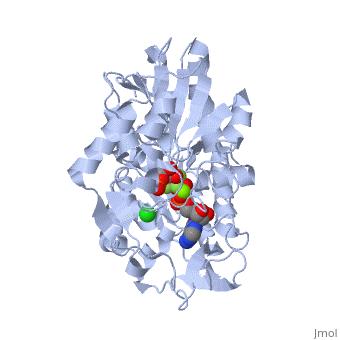Phosphoglycerate Kinase
From Proteopedia
(Difference between revisions)
| Line 1: | Line 1: | ||
| - | <StructureSection load='2y3i' size=' | + | <StructureSection load='2y3i' size='450' side='right' scene='' caption='Human phosphoglycerate kinase complex with phosphoglyceric acid, ADP (stick model) AlF4-, Cl- and Mg+2 ions (green) (PDB code [[2y3i]])'> |
== PGK in the Glycolysis Cycle == | == PGK in the Glycolysis Cycle == | ||
| Line 8: | Line 8: | ||
The overall structure of Phosphoglycerate kinase is very distinctive. It is a monomeric protein consisting of approximately 400 amino acids, with a molecular weight of about 45kD <ref> Auerbach, Gunter et al. 1997. Closed Structure of phosphoglycerate kinase from Thermotoga maritima reveals the catalytic mechanism and determinants of thermal stability. Structure. 5:1475-1483.</ref>. The structure is distinctly bilobed with a depressed region between the two lobes or domains. The lobes/domains are clearly connected at only two locations: <scene name='Shane_Harmon_Sandbox/Domain_links/1'>Beta Sheet L, Residues 189-202 and between Alpha Helix 14 and 15, Residues 404-408</scene>. The SCOP classification of PGK is alpha and beta, indicating that its <scene name='Shane_Harmon_Sandbox/Scop_classifcation/1'>secondary structure</scene>is composed of roughly equal numbers alpha and beta sheets. | The overall structure of Phosphoglycerate kinase is very distinctive. It is a monomeric protein consisting of approximately 400 amino acids, with a molecular weight of about 45kD <ref> Auerbach, Gunter et al. 1997. Closed Structure of phosphoglycerate kinase from Thermotoga maritima reveals the catalytic mechanism and determinants of thermal stability. Structure. 5:1475-1483.</ref>. The structure is distinctly bilobed with a depressed region between the two lobes or domains. The lobes/domains are clearly connected at only two locations: <scene name='Shane_Harmon_Sandbox/Domain_links/1'>Beta Sheet L, Residues 189-202 and between Alpha Helix 14 and 15, Residues 404-408</scene>. The SCOP classification of PGK is alpha and beta, indicating that its <scene name='Shane_Harmon_Sandbox/Scop_classifcation/1'>secondary structure</scene>is composed of roughly equal numbers alpha and beta sheets. | ||
| - | PGK structure shows an open-to-close transition upon hinge bending. PG assumes the open conformation upon release of PGA and ATP. The closed conformation active site contains PGA, ADP and AlF<sub>4</sub>-1 ion which mimics the phosphate ion<ref>PMID:21549713</ref> | + | PGK structure shows an open-to-close transition upon hinge bending. PG assumes the open conformation upon release of PGA and ATP. The closed conformation active site contains PGA, ADP and AlF<sub>4</sub>-1 ion which mimics the phosphate ion<ref>PMID:21549713</ref>. |
| + | *<scene name='38/387911/Cv/2'>Phosphoglycerate binding site</scene>. | ||
| + | *<scene name='38/387911/Cv/4'>AlF4- binding site</scene>. | ||
| + | *<scene name='38/387911/Cv/7'>ADP binding site</scene>. | ||
| + | *<scene name='38/387911/Cv/9'>Whole binding site</scene>. Water molecules shown as red spheres. | ||
== Reaction Mechanism == | == Reaction Mechanism == | ||
Revision as of 08:15, 5 September 2016
| |||||||||||
3D structures of phosphoglycerate kinase
Updated on 05-September-2016
Additional Resources
For additional information, see: Carbohydrate Metabolism
References
- ↑ Auerbach, Gunter et al. 1997. Closed Structure of phosphoglycerate kinase from Thermotoga maritima reveals the catalytic mechanism and determinants of thermal stability. Structure. 5:1475-1483.
- ↑ Lallemand P, Chaloin L, Roy B, Barman T, Bowler MW, Lionne C. Interaction of human 3-phosphoglycerate kinase with its two substrates: is substrate antagonism a kinetic advantage? J Mol Biol. 2011 Jun 24;409(5):742-57. Epub 2011 Apr 27. PMID:21549713 doi:10.1016/j.jmb.2011.04.048
- ↑ Voet, Donald et al. 2008. Fundamentals of Biochemistry. 3rd ed. 499
- ↑ Auerbach, Gunter et al. 1997. Closed Structure of phosphoglycerate kinase from Thermotoga maritima reveals the catalytic mechanism and determinants of thermal stability. Structure. 5:1475-1483.
- ↑ Blake and Rice. 1981. Phosphoglycerate kinase. Philosophical Transactions of the Royal Society of London. 293:93-104.
- ↑ Vas, M, Varga, A et al. 2010. Insight into the Mechanism of of Domain Movements and their Role in Enzyme Function: Example of 3-Phosphoglycerate kinase. Current Protein and Peptide Science. Jan 21, 2010. (Epub ahead of publication).
- ↑ Harnan, G. et al. 1992. Domain Motions in Phosphoglycerate Kinase: Determination of Interdomain Distance Distribution by Site Specific Labeling and Time Resolved Flourescense Energy Transfer. PNAS. 89:11764-11768.
- ↑ Auerbach, Gunter et al. 1997. Closed Structure of phosphoglycerate kinase from Thermotoga maritima reveals the catalytic mechanism and determinants of thermal stability. Structure. 5:1475-1483.
- ↑ Auerbach, Gunter et al. 1997. Closed Structure of phosphoglycerate kinase from Thermotoga maritima reveals the catalytic mechanism and determinants of thermal stability. Structure. 5:1475-1483.
- ↑ Scopes, Robert. 1977. The Steady State Kinetics of Yeast Phosphoglycerate Kinase. European Journal of Biochemistry. 85, 503-516
- ↑ Macioszek, Jerzy et al. 1990. Kinetics of the Two-Enzyme Phosphoglycerate Kinase/Glyceraldehyde-3-Phosphate Dehydrogenase Couple. Plant Physiology 94: 291-296.
- ↑ Shaobo, Wu et al. 2009. PGK1 expression responds to freezing, anoxia, and dehydration stresses in freeze tolerant wood frog, Rana sylvatica. Journal of Experimental Zoology. 311, 57-67
- ↑ Hogg, PJ. 2002. Biological Regulation through protein disulfide bond cleavage. Redox Report. 7(2), 71-77.
Proteopedia Page Contributors and Editors (what is this?)
Shane Harmon, Michal Harel, Joel L. Sussman, Brandon Tritle, David Canner, Alexander Berchansky


